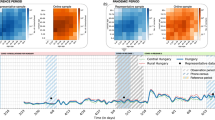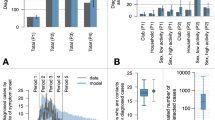Abstract
AN anomaly often noted in surveys of sexual behaviour is that the number of female sexual partners reported by men exceeds the number of male partners reported by women1–3. This discrepancy is sometimes interpreted as evidence that surveys produce unreli-able data due to sex-linked response and sampling bias. We report here that among the 90% of respondents reporting fewer than 20 lifetime partners, however, the ratio of male to female reports drops from 3.2:1 to 1.2:1. The anomaly thus appears to be driven by the upper tail of the contact distribution, an example of the general principle of outlier influence in data analysis. The implica-tion is that sexual behaviour surveys provide reliable data in the main, and that simple improvements can increase precision in the upper tail to make these data more useful for modelling the spread of AIDS and other sexually transmitted diseases.
This is a preview of subscription content, access via your institution
Access options
Subscribe to this journal
Receive 51 print issues and online access
$199.00 per year
only $3.90 per issue
Buy this article
- Purchase on Springer Link
- Instant access to full article PDF
Prices may be subject to local taxes which are calculated during checkout
Similar content being viewed by others
References
Johnson, A. M., Wadsworth, J., Wellings, K., Bradshaw, S. & Field, J. Nature 360, 410–412 (1992).
ACSF Investigators Nature 360, 407–409 (1992).
Smith, T. W. J. Off. Stat. 8, 309–325 (1992).
Johnson, A. M., Wadsworth, J., Wellings, K. & Anderson, R. M. Nature 343, 109 (1990).
Wellings, K. et al. Nature 348, 276–278 (1990).
Smith, T. W. General Social Survey Methodological Report No. 68 (NORC, 1991).
Potterat, J. J., Woodhouse, D. E., Muth, J. B. & Muth, S. Q. J. Sex Res. 27, 233–243 (1990).
Rodriguez, G. & Trussell, T. Pop. Stud. J. Demog. 35, 321–328 (1981).
Hethcote, H. & Yorke, J. A. Gonorrhea Transmission Dynamics and Control (Springer, Berlin, 1984).
Hethcote, H. & Van Ark, J. W. Modeling HIV Transmission and AIDS in the United States (Springer, Berlin, 1992).
Jacquez, J., Simon, C. & Koopman, J. in Epidemic Models: their Structure and Relation to Data (ed. Mollison, D.) (Cambridge Univ. Press, 1993).
May, R. M. & Anderson, R. M. Nature 326, 137–142 (1987).
Anderson, R. M. & May, R. M. Nature 333, 514–519 (1988).
Blythe, S. & Castillo-Chavez, C. Nature 344, 202 (1990).
Blower, S. M., Samuel, W. C. & Wiley, J. A. J. AIDS 5, 633–634 (1992).
Burt, R. S. Soc. Net. 6, 293–339 (1984).
Morris, M. Math. Biosc. 107, 349–377 (1991).
Morris, M. Soc. Meth. Res. 22, 97–124 (1993).
Davis, J. A. & Smith, T. W. The NORC General Social Survey (Sage, Newbury Park, California, 1992).
Author information
Authors and Affiliations
Rights and permissions
About this article
Cite this article
Morris, M. Telling tails explain the discrepancy in sexual partner reports. Nature 365, 437–440 (1993). https://doi.org/10.1038/365437a0
Received:
Accepted:
Issue Date:
DOI: https://doi.org/10.1038/365437a0
This article is cited by
-
Self-Rated Masculinity and Femininity and Reported Number of Lifetime Sexual Partners Among Cisgender Heterosexual and LGBQ Men and Women
Archives of Sexual Behavior (2023)
-
Geographic variation in sexual behavior can explain geospatial heterogeneity in the severity of the HIV epidemic in Malawi
BMC Medicine (2018)
-
Measuring sexual behaviour in Malawi: a triangulation of three data collection instruments
BMC Public Health (2018)
-
Asymptotic theory of time-varying social networks with heterogeneous activity and tie allocation
Scientific Reports (2016)
-
Sexual Mixing in Shanghai: Are Heterosexual Contact Patterns Compatible With an HIV/AIDS Epidemic?
Demography (2015)
Comments
By submitting a comment you agree to abide by our Terms and Community Guidelines. If you find something abusive or that does not comply with our terms or guidelines please flag it as inappropriate.



